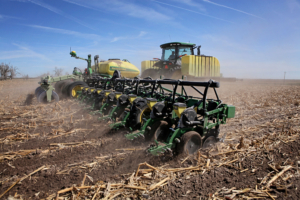
With the 2024 planting season fast approaching, we wanted to give a quick update as we begin thinking about planting. Keep in mind that planting conditions (be it soil temperature, soil moisture, crop residue) will be much different than what we have experienced the past couple of years. Soil temperatures this spring will warm up quickly as soon as we get a ‘warm spell’ to come through. Along with higher soil temperatures, overall soil moisture for planting is also much wetter than the past two years; and crop residue should be more manageable this year, as this past late-fall and winter has led to increased residue breakdown as compared to past few years….tilled fields look much darker this spring before planting than the past few years…
Topics for this Update:
- Early Spring conditions and weather outlook…
- Cold soils and Corn/Soybean Emergence & Disease…
- Things to Keep in Mind when Planting Early…
- Plant First & Hybrid Stress Emergence Ratings…
EARLY SPRING CONDITIONS & WEATHER OUTLOOK
Let’s begin by taking a look at a few weather maps to put things into perspective as we plan to begin planting. Below are the temperature and precipitation forecast maps for the 6-10 day, 8-14 day and one-month periods.




Issue date on these maps is April 3rd. Trends appear to be for warmer and drier conditions beginning early-next week through the 17th. If this holds true, 4″ soil temperatures (currently in the low-40’s), should warm up fairly rapidly. Coupled with good soil moisture at planting depths (due to recent rain and snowfall), this should allow for quick (and hopefully even) germination. Open question is just how wet soil conditions will be when planting begins….however, from these maps, initial trends look positive.

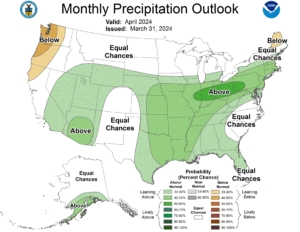
Here are the 0ne-month forecast maps for the month of April, issued on March 31st. As with all of the maps, one should look at them with ‘a-grain-of-salt’, but here too, trends look warmer with higher chances for moisture. As discussed at the Crop Shop meeting in March, bottom line is to have equipment, etc., ready to go when a warm period shows up, as this will be a good time to get some seed in the ground….see emergence discussion below….
COLD SOILS AND CORN/SOYBEAN EMERGENCE
Optimal soil temperatures for planting corn is 50 degrees and above. Imbibition of cold water can lower germination rates and cold soil temperatures can delay emergence allowing for more diseases to set into the seedling. If temperatures go as predicted above, we have a good chance for rapid soil temperature improvement, however, it will still take 4-5 days of such temperatures to reach minimal planting temperatures, especially on a consistent basis, so one will want to allow for a couple of warm days before dropping planter in the ground (as always, what the nighttime temperatures will be is the key thing here). Here is a quick look at how a seed germinates. Imbibition of soil water happens within the first 48 hours and is why it is critical to plant when soil conditions and soil temperatures are right. Main point to keep in mind, is that the best time to plant is heading into a 2-4 day warm temperature period right after planting. Most reduced stands occur when planting into a cold spell, or before giving the soil temperatures time to warm up some right after a cold period….remember, soil temps are currently colder than normal for this time of year. See link below for more info.
Soil Temperature and Cold Emergence
DAYS TO EMERGENCE: SOYBEAN AND CORN
This graph helps explain days to emergence that it takes for both corn and soybeans when soil temps are at different levels. When soil temps are at 50-55 degrees it could take 3 weeks to see emergence. The next graph shows why we recommend planting soybeans early – it’s to maximize our flowering and podding days to allow for more time (days) for pods to set.
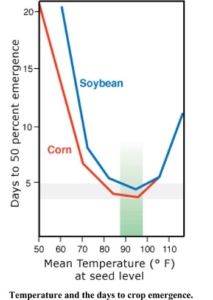
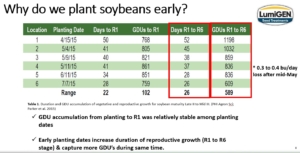
SOYBEAN/CORN EMERGENCE PROCESS:
Soybean Emergence:
Imbibitional Phase:
- Happens less than 24 hours; typically 8-12 hours. After imbibitional phase ends, the risk of chilling injury also ends.
Osmotic Phase:
- A much slower uptake of water occurs. Seedlings can be more tolerant to soil temps as low as 35-40 degrees. Will increase days of emergence and increase risk of soil borne pathogens if soil is cool.
Corn Emergence:
Wait to plant until soil is at 50-55 degrees
- Kernel moisture = 10-12% @ planting
- Imbibition of soil water
- Kernel moisture = 30%
- Soil at 50-55oF
- Enzymes: starch -> sugar
Typically 80 GDU’s: radicle emergence
Typically 130 GDU’s: plant emergence
CORN AND SOYBEAN EARLY SEASON DISEASE REMINDER:
With cool and possibly wet soils, come increase risk of early season diseases. Below are a few pictures of the common early season diseases and fungicides that are rated good to excellent. To the right you will see our seed treatment package with MOA against those diseases. Keep in mind that Pioneer has the industry-leading seed treatments on corn and soybeans. No company has more active ingredients. We have seen the difference over the past few years!
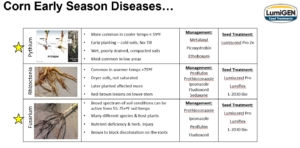
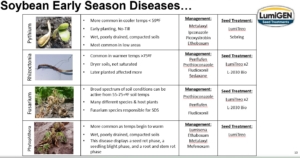
THINGS TO KEEP IN MIND WHEN PLANTING EARLY
- Fluctuating soil temperatures can cause imbibitional seed chilling, erratic emergence and cold temperature injury
- Average last freeze date: 3rd-4th week in April for Central Nebraska…
- Seed Soil Contact is key to fast emergence and stand establishment…..soils that are too wet can lead to side wall compaction, crusting and poor seed to soil contact. In dry conditions, it gets more difficult to get good seed/soil contact as air pockets are increased due to loose and crumbly soil structure.
- Herbicide injury can occur more often in cool, wet soils where the plant isn’t growing at an optimal pace.
- Planting Depth….Optimum planting depth is 1 1/2 to 2″, with 2″ best under normal conditions as this is best for optimal nodal root development. Soil temperature fluctuates more in the top 1” = one reason why we plant at 1 1/2 to 2″ deep. Never plant shallower than 1 1/2″ and we see no reason to go deeper than 2 1/2″. Always err on the deeper side vs. the shallow side for depth. More bushels are lost from too shallow than too deep planting. Optimum soybean planting for soybeans is 1-2″…err on the deeper side under cold conditions.
- Plant populations….Consider increasing population drop under heavy residue and cooler conditions. This is especially so for soybeans….if planting in April consider bumping up seed drop by 10% to offset adverse weather conditions….even more needed if planting in April and no-tilling. Most of the time any replant discussions would’ve been eliminated had seed drop been bumped up at planting.
- Soybean planting date: UNL research shows that you can lose up to ½ bu of yield potential per day after May 1st. Just remember the earlier you can plant you maximize the days of flowering and pod set to give you more time for re-flowering and setting more pods. (Refer to pic toward top)
- Soybean seeding rate: we recommend 140,000-160,000 seeding rates. This seems to give us a good compromise between seed cost and potential loss from storms or other unforeseen events. Here are a few scenarios to consider when looking at seeding rates:
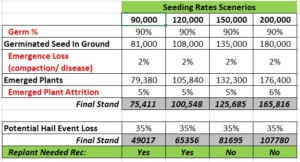
- See links below for more planting time info…
Corn Planting Depth and Spacing
9 Steps to a Perfect Corn Stand
Preseason Planter Checklist
PLANT FIRST RECOMMENDATIONS
One of the most frequently asked question is “What product should I plant first?” With the cooler soil temperatures normally experienced at the beginning of planting, we believe that it is important to start with a hybrid that shows strong emergence and early vigor. The below bullet points show our recommendations for “plant first” products if soil temps are cool. The hybrids are listed by maturity not by how well they emerge. These are products that have shown to have strong emergence and early vigor over the past several seasons. Selecting one of these hybrids to start with can help provide the best chance for optimum emergence when soil temperatures are cooler at the start of planting. However, considering how fast our soils can warm up, and if one is planting into a warm stretch, we don’t have an issue with starting with most any hybrid…key is the first 48-72 hours after planting. Keep in mind the 2-5 day forecast ahead of anytime you are planting. Remember also, that we will continue to experience soil temperature fluctuations as we go through planting….whether planting in April or May….
- 105-109 CRM – P0404, P05466*, P0622*, P0859, ,P09944*, P0924
- 110-118 CRM – P1082, P1164*, P1122, P1170, P1278, P13050*, P13476Q*, P1413, P1563, 17677
- * – very strong emergence….
PIONEER STRESS TEST
You can have confidence in the Stress Emergence scores from Pioneer as they use their own proprietary stress test. The Pioneer Stress Test (PST) is the highest stress level test in the industry which induces cold shock levels not likely to occur unless you would be planting under extended cold conditions! These tests are replicated numerous times from seed harvest thru planting. Replications help reduce variability. Also, Pioneer field calibrates the results of PST scores in numerous plots throughout the Midwest each year so a PST score can be turned into real world stand establishment values.
Specifics of the Pioneer Stress Test
- The Pioneer Stress Test (PST) is a proprietary vigor test used on all Pioneer brand corn products.
- It was developed in early 2000s as an improvement upon the saturated cold test.
- The Pioneer Stress Test imposes extreme imbibitional chilling and anaerobic stresses, beyond that of the saturated cold test.
- PST remains a competitive advantage for Pioneer; Hence protocol and scores are not published
- Stress Emergence scores are the best way to differentiate products for early stand establishment under stress
Please contact us with any questions or comments you may have. Thank you for your business!!
Starman Seed Service, Inc.














